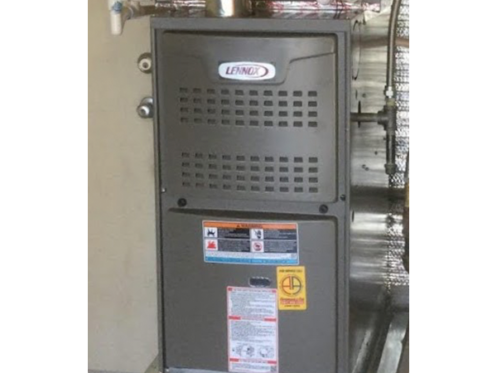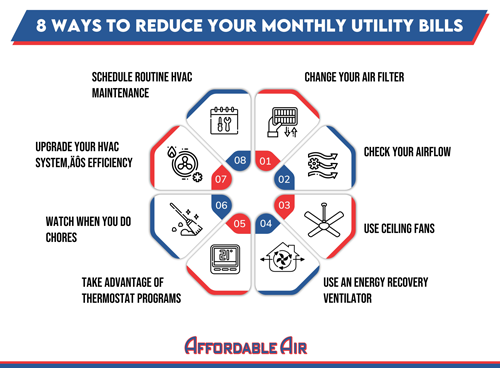Updated: January 2024
Lingering inflation has left everyone looking for ways to save money, and heating and cooling accounts for nearly 50% of your household‚energy consumption. This allocation of energy consumption makes paying attention to your HVAC system worthwhile to find ways to improve how it works. Consider these eight ways you can reduce your monthly utility bill by more effectively managing your HVAC system.
1. Change Your Air Filter
One of the most important things you can do to reduce your HVAC-related energy consumption is to attend to your air filter. Forced-air HVAC systems depend on their ability to circulate air effectively. However, that air contains contaminants that will eventually restrict the airflow through the system. The air filter reduces the number of contaminants flowing into it.
However, as that filter collects those contaminants, they will also restrict the air flowing into the system over time, driving up your energy consumption by causing longer cycles. To reduce this effect, plan to check your filter regularly.
Regardless of your size filter, it is best to check it monthly to catch clogs early on. However, you may not need to change the filter every time you check it. Give it a boost by gently vacuuming the filter every time you check it.
If you have a ductless mini-split system, you likely have washable filters rather than replaceable paper or fiberglass filters. Plan to wash the filter at least monthly and give it time to dry completely before putting it back into your unit.
2. Check Your Airflow
Beyond your filter, there are other facts affecting the airflow around your home. For systems that use a central air handler, the vents are extremely important for distributing conditioned air evenly. The air is distributed through a process that uses positive pressure at the supply vents combined with negative air at the return vents. Block or closed vents cause the system to run longer cycles to achieve the temperature you desire in your home.
Start by checking to make sure that all of your supply vents and doors around your home are open. Next, double-check that every vent has at least a 2-inch clearance around and above it. You may want to consider moving any furniture that are obstructing any vents as this is likely to prevent them from functioning properly.
3. Use Ceiling Fans
Ceiling fans are an incredible addition to your home and can help reduce utility costs without directly contributing to temperature management. Over the summer, the fan makes the air feel cooler through the wind chill effect, making your home more comfortable at slightly higher temperatures.
Over the winter, the heat that your system produces inevitably rises to the ceiling, leaving the air you feel cooler and less comfortable. Running the ceiling fan in reverse helps push that warm air back down, more effectively distributing it throughout your entire space and reducing heating cycle length and frequency.
4. Use an Energy Recovery Ventilator
Your system loses a lot of thermal energy through ventilation, but it is important for managing your home’s air quality. An energy recovery ventilator is one of the best options for reducing that thermal energy loss.
These use a heat exchanger that transfers heat between the outbound air and the incoming fresh air. Over the winter, the inbound cool air absorbs heat from the outbound air. The outbound cool air in the summer absorbs heat from the inbound fresh air, lowering the temperature of the inbound air. In both cases, these ventilators reduce the work your HVAC system needs to do to achieve the temperature set on your thermostat.
5. Take Advantage of Thermostat Programs
Most modern digital thermostats have some kind of programming capability, but many homeowners fail to learn how to use them or how they can benefit them. If your air conditioner or heater is running while you’re not home for extended periods of time, you could be paying for something you’re not present to enjoy. You can reduce this expenditure by adjusting the temperature by as little as 7 degrees while you are away. The Department of Energy estimates you can reduce your annual heating and cooling expense by up to 10% by simply using these programs.
The only time you don’t want to use programs is when you are using a heat pump as your heating system. These particular units use less energy when left at a constant temperature all the time through the cooler months.
6. Watch When You Do Chores
Chores are a necessary part of maintaining your home, but can also drive up your utility expenses for many reasons. The one almost everyone knows is the peak use rate charged by Lancaster Energy between 4-9 pm. However, there are other considerations that drive up the cost of heating and cooling your home too.
Some of your chores generate heat and humidity, such as running your dishwasher or doing laundry. Plan to do these chores outside of peak use periods. Doing so also reduces the impact on your home’s heating and cooling needs, lowering the energy consumed to keep your home comfortable.
7. Upgrade Your HVAC System’s Efficiency
The average furnace has an expected service life of 15 to 20 years, while air conditioners and heat pumps are 10 to 15 years. As these units age, they slowly lose some of their efficiency, even when properly maintained. Further, older units were made with lower efficiency standards than newer models, so they likely started with less efficiency.
If your unit is nearing the end of its service life, you can potentially reduce your energy consumption by upgrading to a more efficient system. Now is a great time to make that change too, with tax credits and rebates available from the Inflation Reduction Act to bring down the cost of upgrading.
8. Schedule Routine HVAC Maintenance
Next to changing your air filter, keeping your system properly maintained is the next most important part of reducing your HVAC energy consumption with your current system. The recommendation is to have a maintenance visit every spring and fall, before the extreme temperatures of summer and winter start. This recommendation is true for both traditional central air and ductless systems.
A maintenance appoint typically does three things that can help reduce your energy consumption. First, your technician will clean the system so that the collected contaminants don’t restrict its airflow. Next, the technician will make adjustments to reduce the strain on the system. This includes adjusting the burner on a furnace and balancing the circulating fan wheel.
They also conduct extensive testing, including visual inspections, testing electrical current and resistance, refrigerant levels, and gas and carbon monoxide leak detection. The idea behind all the testing is that even a small issue will cause the entire system to strain, driving up your energy consumption and increasing wear. If they find something operating outside of optimal parameters, you have time to fix it before it causes this strain.
When people around Lancaster need help keeping their homes comfortable, they call the experts at Affordable Air & Heating. For more than 25 years, our technicians have provided trusted heating and air conditioning installation, HVAC maintenance and furnace repair together with indoor air quality solutions. Call to schedule a consultation with one of our technicians to help find the right energy-saving solutions for your home.
Contact Affordable Air & Heating today!




